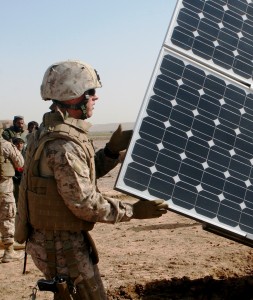Mission Critical: A Clean-Energy Call To Arms
 They say nothing can get done in Washington, D.C. on the issue of clean energy, which has become a political lightening rod over the last year. With Congress at a high watermark of partisanship, accusations abound on Capitol Hill that American energy efficiency and renewable energy technologies and the policies that support them are job killers and a money-wasting hoax on taxpayers.
They say nothing can get done in Washington, D.C. on the issue of clean energy, which has become a political lightening rod over the last year. With Congress at a high watermark of partisanship, accusations abound on Capitol Hill that American energy efficiency and renewable energy technologies and the policies that support them are job killers and a money-wasting hoax on taxpayers.And yet, there’s reason for optimism about energy innovation in this country. Why? Because the most powerful force in the world, the U.S. military, is mobilizing on a clean-energy mission – and I believe they’re going to win this war.
While Congress fumbles, the Department of Defense (DoD) has identified our fossil-fuel dependence as a national security threat which exposes our country to increased vulnerability both at home and abroad. The Army, Air Force, Navy, and Marines have all set aggressive goals – to lower their energy demand, utilize new renewable fuel sources, and develop energy generation, storage, and transmission technologies – that will allow military installations to function more reliably and expeditionary forces to perform more effectively.
Not only that, but the DoD has unequivocally determined that climate change is a “threat multiplier” that will heighten geopolitical instability, resource conflicts, and humanitarian disasters around the globe – stretching the capacity of our Armed Forces to respond. Accordingly, not only is the military dedicated to improving energy performance and diversifying energy sources, it is specifically committed to developing low-carbon technologies.
Secretary of Defense Leon Panetta asserts that all of these initiatives are for one purpose only. “By changing the DoD energy posture, America will have a military that is better able to project and sustain forces around the world to meet any challenges to the nation’s security and interests of the American people.”
Through my work with Environmental Entrepreneurs, I’ve had the privilege to meet with many of the Pentagon’s energy leaders executing this clean-energy mandate, and also to work alongside a number of retired military officers to advance these initiatives. I can say without reservation that these are the best allies the clean-technology sector could have.
DoD brings formidable assets to this mission.
Armed services installations encompass more than 28 million acres of land. DoD plans to install at least 3 GW of renewable-power generation on these bases – the single largest commitment to clean energy in the U.S. It manages more than 2.2 billion square feet of building space for which it is seeking to greatly improve energy and resource efficiency performance. As a massive consumer of fuel (using nearly 2 percent of the nation’s total), and unwilling to sustain the enormous budgetary burden of volatile fuel prices, the military is seeking alternative transportation technologies for its vehicles on bases, as well as its aircraft, ships, and combat vehicles. It is evaluating every aspect of its operations, from energy demand in base housing to the batteries that soldiers carry to battle, and pinpointing where next-generation technologies can improve the nation’s security.
And the military is prepared to invest in these technologies. The Pentagon is requesting $2 billion in fiscal year 2013 for energy improvements to DoD installations and expeditionary operations, with a view to both short and long term results. In many cases these investments will produce huge savings on energy costs.
In the absence of a cogent national energy policy, the military’s actions add up to a national demand signal like no other in the United States today. Because the military is both a strategic (and relatively patient) investor and a huge customer for new energy technologies, DoD’s energy mandates are providing an innovation pull function that holds massive promise for economic growth and job generation in the private sector.
Perhaps most important of all, the military is creating a roadmap for American civilian society, as each vulnerability that the Pentagon has identified with regard to energy security applies at least as much to the general population. From undependable fuel supplies and prices to vulnerable power grids and inefficiencies in our homes and businesses, these liabilities pose an insidious threat to the resilience and strength of our economy and reduce our ability to compete in global markets.
And yet, some in Congress are prepared to sacrifice national and economic security for a partisan agenda. With a visceral disdain for clean energy, or perhaps with an overly robust relationship with the fossil-fuel industries, they are challenging the motives behind the Pentagon’s clean-energy initiatives and threatening to withhold funding to carry them out.
Now is the time to speak out in defense of DoD’s clean-energy initiatives. The annual National Defense Authorization Act is currently being hammered out in both houses of Congress. The House Armed Services Committee has already passed their version of the bill which includes provisions to prohibit the military from investing in and deploying low-carbon renewable fuels. The Senate Armed Services Committee will take up the bill on May 22nd. Whether you’re an employee, a business owner, or an investor in the clean-energy sector, call your representatives in Congress, especially those who sit on the Armed Services Committees, and tell them to support DoD’s clean energy initiatives. Tell them that those initiatives will help you grow your business and create jobs. They need to know you are watching what they do on this and will hold them accountable. Your voice will have more impact than you imagine.
Civilians from across the political spectrum should step up to defend the military’s clean-energy agenda. Uncle Sam really does need you.
You can return to the main Market News page, or press the Back button on your browser.

